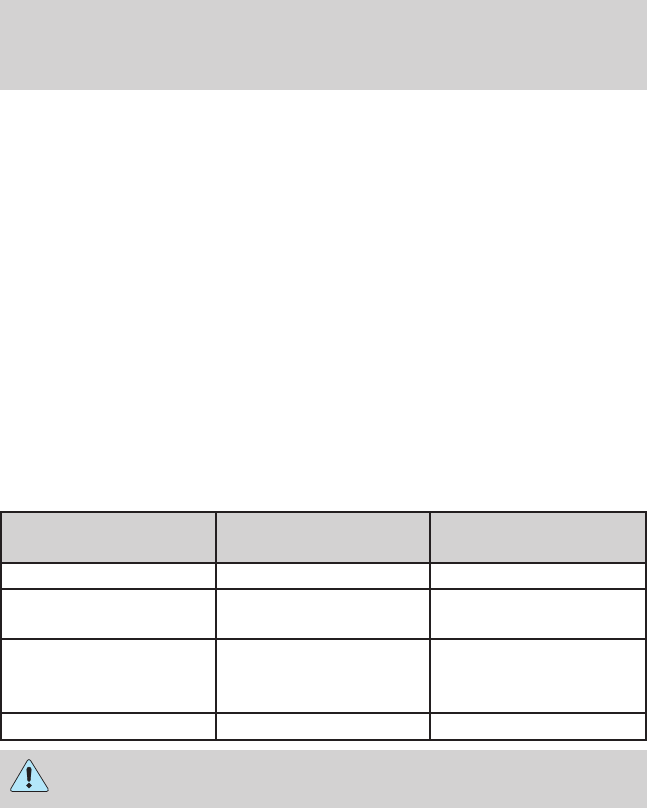Owner's Manual
Table Of Contents
- Table of Contents
- Introduction
- Instrument Cluster
- Entertainment Systems
- Climate Controls
- Lights
- Driver Controls
- MULTI-FUNCTION LEVER
- TILT STEERING WHEEL
- ILLUMINATED VISOR MIRROR (IF EQUIPPED)
- OVERHEAD CONSOLE (IF EQUIPPED)
- CENTER CONSOLE
- AUXILIARY POWER POINT (12VDC)
- POWER WINDOWS
- AUTOMATIC DIMMING REAR VIEW MIRROR (IF EQUIPPED)
- EXTERIOR MIRRORS
- SPEED CONTROL
- MOON ROOF (IF EQUIPPED)
- MESSAGE CENTER (IF EQUIPPED)
- LIFTGATE
- CARGO SHADE (IF EQUIPPED)
- LUGGAGE RACK (IF EQUIPPED)
- Locks and Security
- Seating and Safety Restraints
- FRONT SEATS
- REAR SEATS
- SAFETY RESTRAINTS
- Personal Safety System
- How does the Personal Safety System work?
- Driver and passenger dual-stage airbag supplemental restraints
- Front crash severity sensor
- Driver’s seat position sensor
- Front passenger sensing system
- Front safety belt usage sensors
- Front safety belt pretensioners
- Front safety belt energy management retractors
- Determining if the Personal Safety System is operational
- Safety restraints precautions
- Combination lap and shoulder belts
- Energy Management Feature
- Vehicle sensitive mode
- Automatic locking mode
- Safety belt height adjustment
- Safety belt pretensioner
- Safety belt extension assembly
- Safety belt maintenance
- Safety belt warning light and indicator chime
- BeltMinder
- Personal Safety System
- AIRBAG SUPPLEMENTAL RESTRAINT SYSTEM (SRS)
- Important SRS precautions
- Children and airbags
- How does the airbag supplemental restraint system work?
- Front passenger sensing system
- Determining if the system is operational
- Seat-mounted side airbag system (if equipped)
- Safety Canopy system (if equipped)
- Disposal of airbags and airbag equipped vehicles (including pretensioners)
- SAFETY RESTRAINTS FOR CHILDREN
- SAFETY SEATS FOR CHILDREN
- Tires, Wheels and Loading
- NOTICE TO UTILITY VEHICLE AND TRUCK OWNERS
- VEHICLE CHARACTERISTICS
- INFORMATION ABOUT UNIFORM TIRE QUALITY GRADING
- TIRES
- INFLATING YOUR TIRES
- TIRE CARE
- INFORMATION CONTAINED ON THE TIRE SIDEWALL
- TIRE PRESSURE MONITORING SYSTEM (TPMS)
- SNOW TIRES AND CHAINS
- VEHICLE LOADING – WITH AND WITHOUT A TRAILER
- TRAILER TOWING
- RECREATIONAL TOWING
- Driving
- STARTING
- ENGINE BLOCK HEATER (IF EQUIPPED)
- BRAKES
- STEERING
- PREPARING TO DRIVE
- AUTOMATIC TRANSMISSION OPERATION
- REVERSE SENSING SYSTEM (IF EQUIPPED)
- FOUR WHEEL DRIVE (4WD) SYSTEM (IF EQUIPPED)
- DRIVING THROUGH WATER
- Roadside Emergencies
- Customer Assistance
- GETTING THE SERVICES YOU NEED
- IN CALIFORNIA (U.S. ONLY)
- THE BETTER BUSINESS BUREAU (BBB) AUTO LINE PROGRAM (U.S. ONLY)
- UTILIZING THE MEDIATION/ARBITRATION PROGRAM (CANADA ONLY)
- FORD EXTENDED SERVICE PLAN
- GETTING ASSISTANCE OUTSIDE THE U.S. AND CANADA
- ORDERING ADDITIONAL OWNER’S LITERATURE
- REPORTING SAFETY DEFECTS (U.S. ONLY)
- REPORTING SAFETY DEFECTS (CANADA ONLY)
- Cleaning
- Maintenance and Specifications
- SERVICE RECOMMENDATIONS
- PRECAUTIONS WHEN SERVICING YOUR VEHICLE
- OPENING THE HOOD
- IDENTIFYING COMPONENTS IN THE ENGINE COMPARTMENT
- WINDSHIELD WASHER FLUID
- CHANGING THE WIPER BLADES
- ENGINE OIL
- BATTERY
- ENGINE COOLANT
- FUEL FILTER
- WHAT YOU SHOULD KNOW ABOUT AUTOMOTIVE FUELS
- ESSENTIALS OF GOOD FUEL ECONOMY
- EMISSION CONTROL SYSTEM
- POWER STEERING FLUID
- BRAKE FLUID
- TRANSMISSION FLUID
- AIR FILTER
- MOTORCRAFT PART NUMBERS
- MAINTENANCE PRODUCT SPECIFICATIONS AND CAPACITIES
- ENGINE DATA
- IDENTIFYING YOUR VEHICLE
- TRANSMISSION/TRANSAXLE CODE DESIGNATIONS
- Accessories
- Index

The front passenger sensing system is designed to enable (may inflate)
the front passenger’s frontal airbag anytime the system senses that a
person of adult size is sitting properly in the front passenger seat.
• When the front passenger sensing system enables the front passenger
frontal airbag (may inflate), the indicator will be unlit and stay unlit.
If a person of adult size is sitting in the front passenger’s seat, but the
⬙passenger airbag off⬙ or ⬙pass airbag off⬙ indicator lamp is lit, it is
possible that the person isn’t sitting properly in the seat. If this happens:
• Turn the vehicle off and ask the person to place the seatback in the
full upright position.
• Have the person sit upright in the seat, centered on the seat cushion,
with the person’s legs comfortably extended.
• Restart the vehicle and have the person remain in this position for
about two minutes. This will allow the system to detect that person
and enable the passenger’s frontal airbag.
• If the indicator lamp remains lit even after this, the person should be
advised to ride in the rear seat.
Occupant
Pass Airbag Off
Indicator Lamp
Passenger Airbag
Empty seat Unlit Disabled
Small child in child
safety seat or booster
Lit Disabled
Small child with safety
belt buckled or
unbuckled
Lit Disabled
Adult Unlit Enabled
Even with Advanced Restraints Systems, children 12 and under
should be properly restrained in the back seat.
After all occupants have adjusted their seats and put on safety belts, it’s
very important that they continue to sit properly. A properly seated
occupant sits upright, leaning against the seat back, and centered on the
seat cushion, with their feet comfortably extended on the floor. Sitting
improperly can increase the chance of injury in a crash event. For
example, if an occupant slouches, lies down, turns sideways, sits forward,
leans forward or sideways, or puts one or both feet up, the chance of
injury during a crash is greatly increased.
2007 Mariner (mrn)
Owners Guide (post-2002-fmt)
USA (fus)
Seating and Safety Restraints
110










